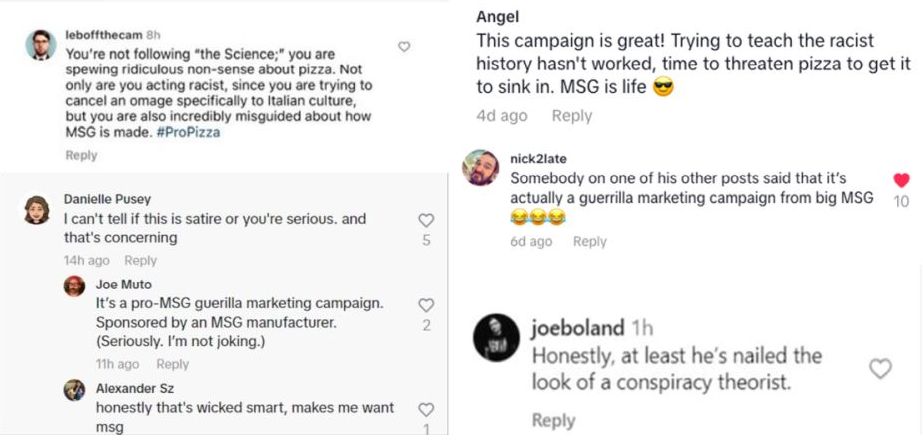
Problem Solved: Ajinomoto MSG’s Social Media Conspiracy Campaign to #CancelPizza

Edelman recently wrapped one of its wildest campaigns ever for Japanese multinational food and biotechnology corporation, Ajinomoto. Last month, Edelman hired an actor to purposefully spread a slow-burn, incendiary campaign online. Ajinomoto is the leading global supplier of monosodium glutamate (MSG), but that wasn’t initially apparent to viewers. Deploying the same tactics used in a misinformation campaign, they called for the world to #CancelPizza.
For the last five years, Edelman has been working with Ajinomoto to fight undeserved criticism and misinformation about its product. This new drastic measure followed a chorus of other campaigns like ‘#RedefineCSR’, ‘#DinnerWithGoop’ and ‘#TakeOutHate’. Like those, ‘#CancelPizza’ aimed to ignite a broader conversation about MSG but this time, Edelman decided to fight lunacy with lunacy.
The campaign’s actor (Tyler Coleman) launched the red-string theory campaign with a crazed TikTok video in which he uncovers that MSG is in naturally occurring pizza ingredients, and calls for pizza to be cancelled. Publishing more ridiculous content online as the weeks went on, and with a trove of influencers at the ready to fan the flames, the goal was for ‘#CancelPizza’ to inadvertently debunk myths about MSG and educate consumers about its ubiquity in everyday foods.
‘#CancelPizza’ picked up serious traction on TikTok, with over 35.7million views of the hashtag in just three weeks. On August 9th, Ajinomoto publicly took responsibility for the effort.
LBB’s Addison Capper picked the brains of Edelman’s Conor Hogan (creative director) and Jesse Suchmann (executive creative director) to find out more about how it all came to be.
What You Made
It sounds a little wild, but we created a social media conspiracy campaign for Ajinomoto designed to spread real facts and combat misinformation. ‘#CancelPizza’ was our satirical effort to point out the absurdity of baseless bans of monosodium glutamate, or MSG.
After quietly claiming the @CancelPizza handles across all major social platforms, we released a steady stream of unhinged ‘conspiratorial’ content into social feeds. At the centre was a single man attempting to convince the world of this truth: if people are going to cancel monosodium glutamate, then we must also cancel foods where MSG naturally occurs… like pizza.
So for two weeks, he stood in his poorly lit basement in front of a red-string theory corkboard, posting video after (shaky) video that directed millions of people to CancelPizza.net. While there, they could sign his petition and learn why eating tomatoes, garlic, and Parmesan is just as safe as eating MSG.
The Problem
People in the United States have an irrational fear of MSG. Not all of them, but many of them. Despite piles of research that prove MSG’s safety, a significant chunk of the American public still hasn’t been swayed by facts and science. The brief was to explain that chemically, MSG is made up of the same molecules that people eat in many everyday foods. The human body metabolises the sodium and glutamate in monosodium exactly the same way as they do the sodium and glutamate in foods like tomatoes, onions, mushrooms, garlic and Parmesan cheese. So, our job was to give people a chemistry lesson that wasn’t hard to swallow. See what I did there?
Ideation
From the outset, we wanted this campaign to be led by science, but we knew that facts alone rarely break through. The science has been clear for a long time, yet misinformation about MSG is everywhere. We were specifically intrigued by the irony that the same people who are quick to condemn MSG, often embrace foods with naturally occurring MSG. If there was an unexpected way to call out that contradiction, our theory was that it would motivate people to dive into the science of MSG safety.
As we brainstormed, we noticed that some of the most glutamate-rich foods in the world were also ingredients in the most beloved dish in the US: pizza. That sparked an idea. What would happen if someone disliked MSG so much that they started a nationwide movement to #CancelPizza? The backlash would be immediate, but we knew that people would also wonder…why?
As we pushed the #CancelPizza concept forward, its most natural potential format was the type of conspiracy content you run across every day on TikTok. One slightly unhinged and often unshaven dude, in his home, confidently attempting to educate viewers on a subject that he feels he is an expert in. If we could execute the proper production design and cast the right actor to explain the science of MSG and pizza ingredients in a format like that, it might stop people in their feeds long enough to digest the actual science.


A selection of responses to the social media posts
Prototype and Design
Our plan was to blast out ‘#CancelPizza’ across all platforms, but TikTok felt like it had to be the focus. So we held our noses and studied the conspiracy content that tended to go viral. The lighting. The sound. The (lack of) camera moves. The environment. The lo-fi graphics. ‘#CancelPizza’ would only work if people actually wondered if it was real, and didn’t immediately dismiss it as a conspiracy-themed commercial. So, alongside our very brave Ajinomoto clients and a killer production team in Tuff, we began architecting the campaign.
Every element had to feel as if this one person was behind the movement. There was no glam or wireless mics. The entire shoot was captured on a single iPhone, either on a tripod or operated by the talent himself. All props were homemade and extremely DIY. If there was an editing effect or camera technique that wasn’t possible on TikTok, we didn’t use it. The fictional character at the centre of our campaign cared about facts and science, but wasn’t a savvy content creator or web developer, and the content reflected that at every touchpoint. The messiness of the CancelPizza.net aesthetic almost gave our design team a panic attack. If anything felt too polished, our direction was to make it look worse. That’s probably the last time we can do that for a client, but it was really a blast.
It’s interesting to note, though, that after all the work our team did to keep it lo-fi, TikTok commenters still called out elements that seemed suspiciously well produced, and we kicked ourselves for each tell. It turns out that the conspiratorial basement dweller aesthetic is a very, very delicate vibe to pull off.
Live
When it finally went live, we definitely got the community response we were hoping for. Viewers were baffled by the ‘#CancelPizza’ call to action, but stuck around long enough to listen to his rationale and learn about the science. It was interesting to see how the comment sections of various social platforms differed: with TikTok trending towards armchair researchers that verified the facts and science and celebrated it as a clever way to spread the info. TikTok got what we were doing, then shared it once they were in on the joke. Instagram commenters, on the other hand, couldn’t quite decide whether or not he was a real conspiracy theorist and argued about it endlessly. Seems like good fodder for a media literacy thinkpiece.
But regardless of their conclusion about our hero, everyone who engaged in the debate encountered the dry, fact-based scientific messaging about glutamic acid we were hoping to get across. This whole campaign was a straightforward science lesson inside the Trojan horse of a TikTok conspiracy theory.
‘#CancelPizza’ was obviously different from anything we’ve done before. We sort of threw ourselves towards what really travels in today’s media environment, even when it required major departures from how the brand is used to looking and behaving. But we all agreed that the facts and science were the most important thing, and if we wanted them to spread faster than the misinformation that surrounds us every day, we had to try something new. We essentially created a campaign about molecular chemistry, and by packaging it this way, people actually paid attention. So, basically, the plan worked. In the end, millions of people were exposed to high-quality information, and that is something we are extremely proud of.













